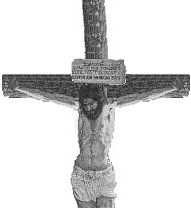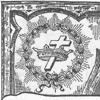Jehovah's Witnesses Cross
As with several other fundamental aspects of Christianity, indeed the very core of Christianity, the Jehovah's Witnesses have alternative views.
Jehovah's Witnesses believe that Jesus was executed but many also believe that Jesus Christ did not die on a cross. They support their beliefs through their own New World Translation (NWT) of the Bible, which they much prefer to versions used by the Church. One particular alternative translation is in regard to the cross.
Some Jehovah's Witnesses are changing their thoughts on the matter but probably most still follow the official line that Jesus was crucified on a stake, a simple upright post, with no patibulum (cross beam).
Historians and etymologists have debated whether the early Scriptures word stauros (the apparatus used as a scaffold for crucifying Jesus) should be translated as a simple upright post, or a post with a cross beam (either a ✝-shaped Latin Cross, a Y-shaped Forked Cross, an X-shaped St. Andrew's Cross or a T-shaped Tau Cross). The consensus is that it was not a simple upright post.
The distinction may appear to be not as important as the reason why Jesus was executed, but actually the shape of the cross has a very strong relationship to the reason. And as Jehovah's Witnesses pride themselves as being literal readers of the Scriptures, they should look very carefully the shape and form.
What the Scriptures say
The Bible says that Jesus was hung on a tree (Church Bible) or stake (NWT). Whether it was an actual rooted tree or an upright wooden post set into the ground, it's most likely that a patibulum was then added. A usual crucifixion method was to bind the condemned person's wrists to a beam and then attach that beam to a tree or stake, thereby forming a cross.
It's because this was a "usual crucifixion method" that the Jehovah's Witnesses and their offshoot, the Friends of Man and others such as the Mormons, assert it was just an upright stake. They add that the cross has ancient Pagan origins and is consequently not appropriate to associate with the Crucifixion of Jesus.
However, as torturers well know, it's advantageous to torment a victim with something they would find abhorrent. In fact, the humiliation of Jesus was prophesied and part of God's plan to bear the sin of mankind.
The Crown of Thorns was also humiliating and we should recall that both the cross and the crown were initially an emblem on the Jehovah's Witness 'Watchtower' magazine.
The Jehovah's Witnesses founder and president (1879-1916), Charles Taze Russell, made a logo with the Crown and Cross, which is strikingly similar to many Freemason emblems. This is not surprising since Russell was well educated in pyramidology and Masonic thought.
Today, however, the Watch Tower Society flatly denies that their founder was a Mason and distances itself as far as possible from secret societies. They are not the only religion to have changed their doctrine, and no doubt they will continue change their ideas in the future.
Contemporary Watchtower covers retain the humiliating Crown of Thorns in the form of a crenelated tower, beneath which is a capital letter 'T', the shape of a Tau Cross.
Evidence that it was NOT a stake
As mentioned above, Jehovah's Witnesses are known for taking the Bible literally rather than figuratively. So here are some passages from their own version (NWT) that say the same as the Church Bible such as King James Version (KJV):


Matt. 27:37 (NWT) - Also, they posted above his head the charge against him, in writing: "This is Jesus the King of the Jews."
Matt. 27:37 (KJV) - And set up over his head his accusation written, THIS IS JESUS THE KING OF THE JEWS.If Jesus had been crucified on a simple upright post, his arms would have obscured the writing above his head. Matthew quite clearly records that the writing was above the head of Jesus, not above the hands.
Not an entirely convincing argument on its own, but let's now add...

'Doubting Thomas' states:
John 20:25 (NWT) - Unless I see in his hands the print of the nails...
John 20:25 (KJV) - Unless I see in His hands the print of the nails...If Jesus' hands had been nailed together above his head, just one nail would have sufficed. But John 20:25 has been specifically translated (in both versions of the Bible) as "nails" (plural), which would be the case for hands nailed separately on a patibulum.
Plus...
Jesus had been severely beaten before being forced to carry the heavy timber from the city to Golgotha. In that weakened condition, it would have been impossible to carry the complete scaffold, whatever design it might have been. In any case, the upright post would have been already installed on the execution site. Therefore what did Jesus carry if it wasn't the patibulum?
And last but certainly not least...
Crucifixion is not just to end life; decapitation could do that swiftly. The aim of crucifixion is to prolong the agony of death and that is what a patibulum does.
With arms raised above the head, the rib cage is forced to expand and breathing is difficult. For a weakened victim, suffocation brings forward the relief of death. Using a sedile and with arms fastened to a patibulum, breathing is less effort and the dying process is prolonged. In the case of Jesus, the process was so long that in the end, a soldier had to pierce the side of Jesus with a spear to make sure death occurred before the Sabbath.
So what's the big fuss about?
Whatever sophistry we choose, the fact remains that Jesus was crucified and died that our sins might be forgiven. Jehovah's Witnesses will agree that a stake or a cross makes not the slightest difference to that fact.
Christians of mainstream denominations tend to have less time to be diverted by such debate. Christians do not worship the cross (and it's unlikely ancient Pagans worshipped it either). Christians worship the risen Christ. The Bible doesn't tell us the shape of the cross, its weight, dimensions, age, what kind of wood it was, etc., because that is neither the purpose nor nature of the Bible.
By fully understanding the Bible (and not a particular group's own interpretation), believers can easily work out for themselves what the shape was.
In many ways, until a few hundred years ago Christians lived a much less complicated life than we do today. Thought and belief was more intuitive that today, where we are encouraged to see things rationally. The downside of this is that we talk about God in very simplistic terms; based on literal reading of Scriptures rather than personal experience with God. We should look at our religion from a spiritual angle more than intellectual.
Is the cross Pagan?
The stake / cross debate is a diversion. The Watch Tower Society links the pre-Christian existence of the cross to Paganism and therefore associate "those claiming to be Christians" with Paganism. The aim is to discredit the KJV Bible by attempting to prove their own version. But merely by citing their own version is not a very convincing method of proof!
Elementary research shows that the cross was not invented for the crucifixion of Jesus so of course, it does have a pre-Christian origin. And a pre-Christian origin is no reason for rejection. In any case, even if it was a simple stake with no patibulum, such apparatus was also used by Pagans prior to the Phoenicians' addition of the cross-bar.
Most Christians believe in the Holy Trinity. Trinitarianism is a useful way to express in words the inexpressible, and it was also used in some Pagan religions. Trinitarianism might be seen as a 'gift' from some pre-Christian religion, or more likely, God's way of conditioning mankind to more easily understand Him. But trinitarianism is rejected by Jehovah's Witnesses because again, it was a belief of pre-Christian religions.
Jehovah's Witnesses are nontrinitarian, just like the Pagan Egyptian Pharaoh, Akhnaton, who believed in one god, Aton. The pantheons of pre-Christian religions all had one major god at the 'top', so to speak, of their hierarchy.
So rejecting the cross and trinitarianism because they were used by Pagans is flawed logic, since the alternative stake and nontrinitarianism were also used by Pagans.
Ancient religions also gave us hymns (and JW Kingdom Songs), church buildings (and JW Kingdom Halls), priests (and JW Ministerial Servants), days of the week named after Pagan gods (used by JWs), and several other Pagan items adapted by Christians.
Jehovah's Witnesses
To any Jehovah's Witness reading this page, a hearty welcome! We are glad you're surfing the internet, exploring, examining your doctrines objectively.
If we look too closely at a tree, then we miss seeing the whole forest.
References
The above is based on the Watch Tower Bible and Tract Society's own publication (the New World Translation) and the King James Version of the Bible. Additional material has been gleaned from a paper by Leolaia (jehovahs-witness.net/watchtower/bible/92381/1/The-facts-on-crucifixion-stauros-and-the-torture-stake, no longer online).
jw.org/en/publications/magazines/g20041208/The-Internet-How-to-Avoid-the-Dangers is where the Watchtower Society tells us of the danger of seeing pornography on the web, and how some of these smooth-talking sites appear innocuous yet they can brainwash us.
We agree. And also agree that the Jehovah's Witnesses use identical 'thought reform' techniques.
Yes, it might well have been used by pagans, and other cultures who crucified people.
There's no evidence to suggest crucifixions were suddenly invented for the execution of Jesus.
"In antiquity crucifixion was considered one of the most brutal and shameful modes of death. Probably originating with the Assyrians and Babylonians, it was used systematically by the Persians in the 6th century BC. Alexander the Great brought it from there to the eastern Mediterranean countries in the 4th century BC, and the Phoenicians introduced it to Rome in the 3rd century BC. It was virtually never used in pre-Hellenic Greece."
pubmed.ncbi.nlm.nih.gov/14750495/#:~:text=In%20antiquity%20crucifixion%20was%20considered,in%20the%206th%20century%20BC.
"Tree" (KJV): Acts 5:30, 10:39, 13:29, Gal. 3:13, I Pet. 2:24
"Stake" (NWT): Acts 5:30, 10:39, 13:29, Gal. 3:13, I Pet. 2:24
Friends of Man is a small Swiss-based church that emerged from the Watch Tower Society in 1916. They should not be confused with the Colorado charity or the Australian rock band of the same name.
General William Huntington Russell (reportedly the uncle of Charles Taze Russell) was deeply involved in Freemasonry and co-founded the infamous Skull and Bones Society. The early speeches of Charles Taze Russell contain much Masonic terminology.
The June 1997 issue of The Watchtower (issue no longer online) warns against 'secret societies', without admitting that the Watchtower Society is itself, a secret society.
Jehovah's Witnesses are not alone in changing their doctrine. If the changes underscore principles of faith, then those changes are sanctioned, even though they may upset many followers.
Most religions change with the times, otherwise they would fizzle out of existence.
See Flexible truths
See INRI
See Why Jesus Died
jw.org/en/publications/magazines/awake-no2-2017-april/the-cross-is-it-biblical/ carefully picks from selected translations that support their stance.
jw.org/en/publications/books/bible-teach/origin-cross-symbol-pagan goes on to explain that "True Christians" do not use the cross, which contradicts what Jesus said.
- The King James version (and practically every other translation): "Then said Jesus unto his disciples, If any man will come after me, let him deny himself, and take up his cross, and follow me."
- Jehovah's Witnesses New World Translation: "Then Jesus said to his disciples: If anyone wants to come after me, let him disown himself and pick up his torture stake and keep following me."
Sadly Jehovah's Witnesses fail to understand why the cross is so important theologically and spiritually; issues that this page attempts to explain.


